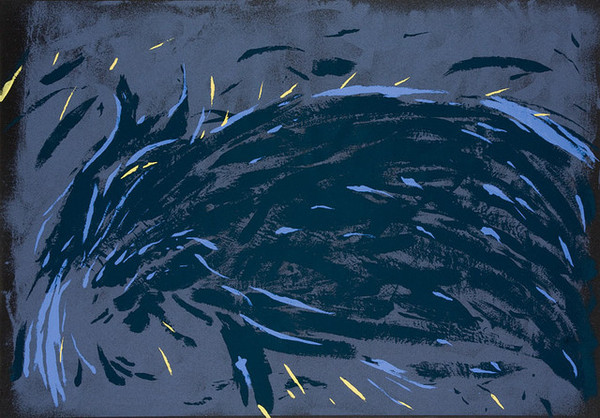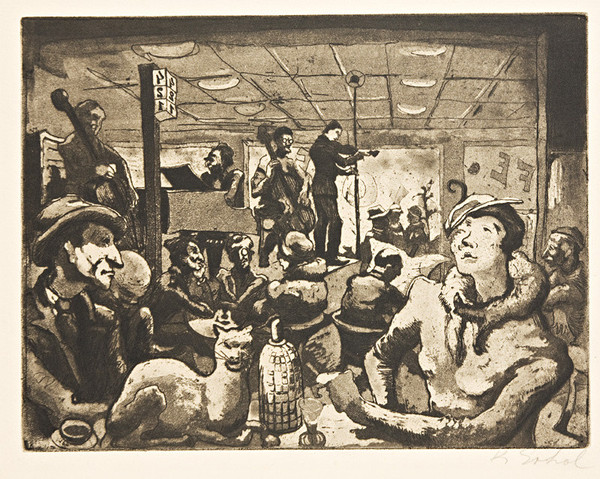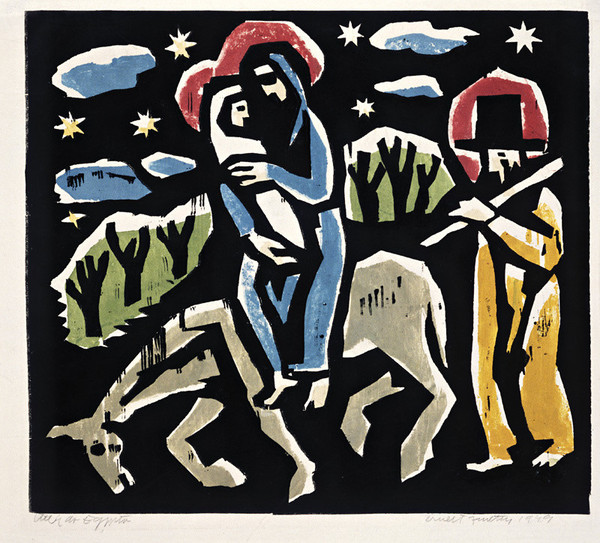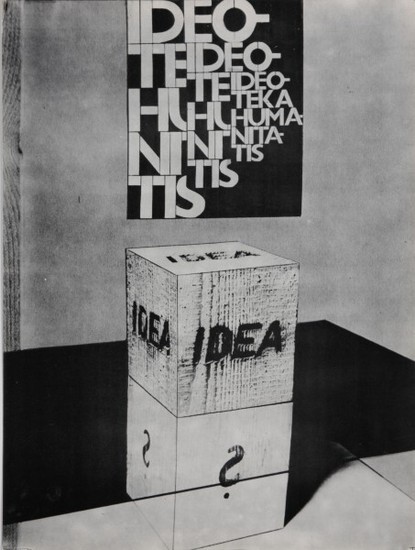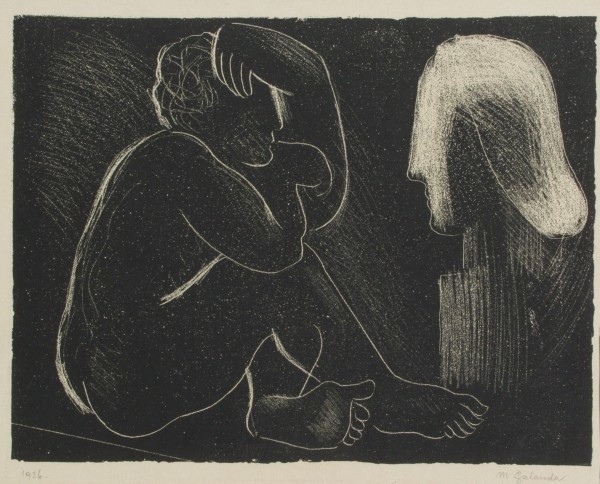The Collection of Modern and Contemporary Graphic Art from 1900 is
outlined as the fund of the graphic art - a specific kind of art based
on the principle of the creation of the author's prints from the
original (print form) predominantly on paper.
In the 20th
century, graphic art experienced a significant development of
traditional techniques as well as the introduction of new techniques. In
terms of orientation, the individual works of the collection include
free and applied graphic art (ex libris, original reproduction,
illustration). Free graphic sheets represent the work of all of the main
figures and forms of graphic art of the 20th century, from lithographs
and etchings through expressive modern wood-cuts and wood-engravings up
to unique monotypes whose technique lies somewhere between painting and
graphic art, because every print is the original transferred from a new
layer of paint to the model. Thematically, the collection presents
extremely rich material for the study of the history of graphic art in
the Central European milieu at the end of 19th century and the beginning
of the 20th century.
The collection of graphic art was
established upon the founding of the SNG in 1950. It includes
approximately 13,000 works, predominantly of Slovak and Central European
origin and a sample of international graphic art (Japanese woodcuts by
an unknown author, etchings by J. Villon, M. Klinger, E. Nolde, P.
Picasso and L. Feininger, lithographs by O. Kokoschka and F. Léger,
wood-engraving by K. Kollwitz, lithography by A. Frohner, monotype and
collage by S. Hu, serigraphy by A. Warhol).
Czech graphic art
is well represented in this collection and has been throughout the
entire history of acquisitions (etchings by V. Pressig, M. Švabinský,
wood-engravings by F. Bílek, J. Váchal, engravings by O. Kubín, E.
Filla, J. Šíma, lithographs by M. Jiránek, K. Lhoták, a set of
engravings and monotypes by V. Boudník, engravings by K. Malicha, N.
Plíšková, J. Anderle, perforated engravings by A. Kučerová, lithographs
by J. Balcar, serigraphy by R. Kratina, lino-engraving by M. Rittstein
and a large set of ex libris and graphic sheets by various authors from
the first half of the 20th century).
The collection contains
several significant works of Polish artists from the second half of the
20th century and many graphic sheets by unknown Hungarian, Belgium,
French, German and Czech authors from the turn of the 20th century,
which is a result of the fact that, particularly in the first decade
after the founding of the gallery, graphic art was acquired not only
through transfers from already existing institutions (for example the
Slovak National Museum), purchases from private owners, authors and
families, but also through purchases from antique shops and antiquarian
bookshops. In 1955, the gallery's purchase commission were already
divided into old and contemporary art. This collection was also built in
two lines since its beginning, by supplementing works from the first
half of the 20th century and by acquisitions of contemporary artists'
works.
The works from the first two decades of the 20th
century are represented by the integral sets of works by authors
connected with the end of the 19th century and landscape painting
(etchings by M. Schurmann, lithographs by Ľ. Csordák), Budapest Academy
realism (G. Angyal), as well as the beginnings of modern graphic art
represented by E. Krón, whose influential drawing school in Košice
attended also Koloman Sokol. Krón's cycle of lithographs Muž slnka I. -
V. (Man of the Sun I - V)(1920 - 1930) is particularly based on Cubism;
at the same time, it re-evaluates the impulses of Jasusch-like
Expressionism and Art Nouveau. A large set of wood-engravings,
lithographs and etchings of Sokol presents one of the most significant
Slovak graphic artists who made good use of the influence of expressive
tendencies in eastern Slovakia and the European inter-war avant-gardes
as well as thorough instruction in Mexican art - it was in Mexico
where he established his own graphic school while working there.
The
full development of avant-garde attitudes towards art in graphic works
can be seen in the work of Ľ. Fulla amd M. Galanda, who in (coloured)
lithographs, linoleo-cuts and engravings, synthesized the mutual
liberation of line, shape and stain and their use as autonomous elements
of composition with a search for authentic modern expression typical
for Slovak art. The topicality of their performance is also suggested by
the harmony with various streams of European Modernism from the
beginning of the 20th century.
The collection also maps the
graphic implementations of representatives of the national Modernism of
M. Benka, M. A. Bazovský and Z. Palugyay in lithographs, linoleo-cuts
and monotypes. The graphic work of the representatives of the Generation
of 1909 (according to the exhibition by K. Vaculík and Ľ. Peterajová
Generácia 1909 - Svedomie doby v roku 1964 (Generation 1909 - The
Conscience of the Times in 1964)) is also documented in this collection.
V. Hložník and C. Majerník are represented by larger sets of works.
Acquisitions
of the graphic art of the inter-war generation of artists such as D.
Milly, K. Ondreička, A. Nemeš, E. Nevan began with the works from the
1930s. Significant graphic artists, O. Dubay, A. Klimo, E. Zmeták, E.
Špitz were already creating in the 1940s when M. Čunderlík was starting
his career. The works from the collection which are dated from the
beginning of the 1950s were already subjected to the multi-layer filter
of the aesthetic requirements of the socialist regime - from socialist
realism in the 1950s up to illustrative figuration in the 1970s and
1980s.
Despite the fact that considerable material was
included in the collection, which precisely documents this ideological
pressure, it is possible to identify a large number of quality
figurative work. The imaginative tendencies of Slovak graphic art, as it
was formed by the circle of artists including A. Brunovský, R. Bruno,
later V. Gažovič, D. Kállay, K. Štanclová and many others, belong to the
most distinctive stream.
However, the extensive parallel
collections of another progressive type were also successfully built.
They predominately include the works of certain artists from the Group
of Mikuláš Galanda (M. Laluha, A. Barčík and M. Paštéka) and the group
of Bratislava Confrontations, testing the medium of graphic art in a
completely new material level of informel character. Together with a
representative selection of structural and explosionalist graphic works
by V. Boudník, the works created by monotype technique and the combined
technique by M. Čunderlík, J. Kočiš, D. Kočišová, J. Jankovič and E.
Ovčáček constitute the golden fund of the graphic art collection.
The
neo-Constructivist tendencies in graphic art were fully manifested in
the works of M. Urbásek T. Klimová and M. Dobeš. The artists of the
wider neo-avantgarde circle, particularly of pop-art and neorealist
tendencies such as S. Filko, J. Želibská, R. Sikora, J. Meliš and J.
Jankovič in part, contributed to graphic art in a specific way.
In
the 1970s, the collection captures the graphic work of artists from the
field of hyperrealism (V. Rónaiová), analytical painting and graphic
art (M. Mudroch, D. Fischer), as well as the first computer graphic
works by J. Jankovič and later by D. Fischer. The new expressive
position of the 1980s is represented by the graphic work of the "new
wild" generation of artists such as L. Teren, I. Csudai, S. Černý, and
M. Krén and P. Rónai, who adopted postmodernism.
Recently,
the collection gained new coloured lithographs of Palo Čejka a Marek
Blažo, who develop new themes as interpretations of graphical
phenomenons long known in the art history. Other positions of the
contemporary graphic art are represented by computer graphics as outputs
of the virtual studio of V.Havrilla, the work of the neo-Conceptual
generation beginning after 1989 and digital print as a progressive
graphic medium (M. Kvetán).
